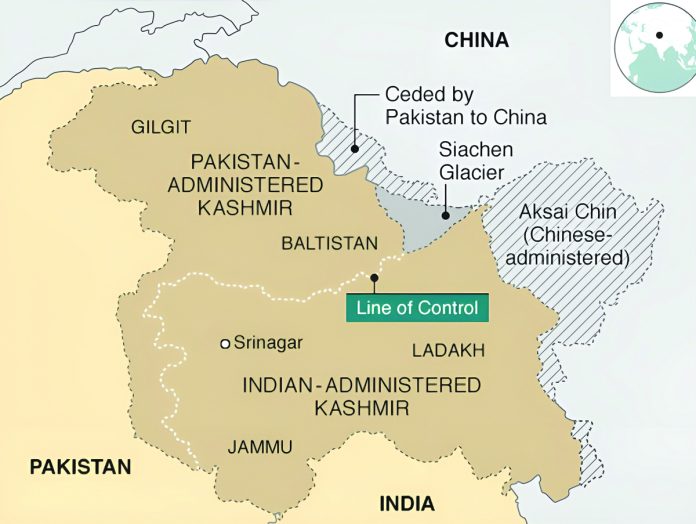Wajeeha Najam
The India-Pakistan relationship remains one of the most volatile and intractable conflicts in contemporary international relations, with recent developments further worsening tensions between the nuclear-armed neighbors. The terrorist attack in Indian-administered Kashmir on April 23, 2025, which killed 26 tourists, has reignited hostilities at a time when existing mechanisms for conflict resolution appear increasingly fragile.
This incident, coupled with Pakistan’s persistent advocacy for Kashmiri self-determination and growing tensions over water-sharing agreements, creates a perfect storm that threatens to push the region toward renewed conflict. The complex interplay between these issues demands careful examination, as their resolution – or continued stalemate – will have profound implications for regional stability and security.
At the heart of the bilateral tensions lies the decades-old Kashmir dispute, which has defied resolution despite numerous international interventions and bilateral attempts at negotiation. Pakistan’s official position, rooted in the United Nations Security Council resolutions of 1948-49, maintains that the Kashmiri people should exercise their right to self-determination through a plebiscite. This stance has remained consistent throughout Pakistan’s political history, though its practical implementation has varied across different administrations.
India’s revocation of Article 370 in August 2019, which stripped Jammu and Kashmir of its special autonomous status, dramatically altered the political landscape and further complicated Pakistan’s diplomatic position. The move was interpreted by Islamabad as an aggressive attempt to unilaterally change the status quo, leading to a hardening of positions on both sides. The April 2025 attack, which Indian authorities have attributed to Pakistan-based militants, has only served to reinforce New Delhi’s narrative that cross-border terrorism remains Pakistan’s preferred instrument of policy in Kashmir.
India’s response to the attack reflects its evolving counterterrorism strategy, which has increasingly emphasized military and economic measures over purely diplomatic approaches. The characterization of the incident as an “act of war” by Indian officials suggests a potential escalation in rhetoric that could presage more aggressive responses. This hardening stance is mirrored in India’s domestic political landscape, where nationalist sentiment has made compromise on Kashmir increasingly difficult for any government in New Delhi. Meanwhile, Pakistan’s continued insistence on framing the Kashmiri struggle as one of self-determination, coupled with its denials of involvement in cross-border militancy, creates a fundamental impasse in bilateral relations. The resulting dynamic is one where neither side can afford to appear weak or conciliatory, locking both countries into a cycle of confrontation with no clear exit strategy.
The situation is further complicated by the involvement of external powers, particularly China, whose growing strategic partnership with Pakistan has introduced new dimensions to the conflict. Beijing’s willingness to shield Islamabad from international censure through its veto power at the United Nations Security Council has emboldened Pakistan’s position on Kashmir, while simultaneously deepening India’s suspicions of a coordinated effort to undermine its territorial integrity. At the same time, India’s strengthening strategic ties with the United States and other Western powers have transformed what was once a bilateral dispute into a theater of great power competition. This internationalization of the conflict makes resolution even more challenging, as both India and Pakistan can now rely on external patrons to mitigate the costs of their confrontation, reducing incentives for compromise.
Parallel to the Kashmir conflict, tensions over water sharing present another potentially explosive flashpoint in bilateral relations. The Indus Waters Treaty, brokered by the World Bank in 1960, has long been held up as a rare example of successful cooperation between the two rivals, having survived three major wars. However, the treaty now faces unprecedented strain due to a combination of climate change, population growth, and political tensions. India’s construction of hydroelectric projects on rivers allocated to Pakistan under the treaty, particularly the Chenab and Jhelum, has raised serious concerns in Islamabad about potential water shortages. For Pakistan, where over 60 percent of agriculture depends on the Indus basin, any significant reduction in water flows could have catastrophic consequences for food security and economic stability. The situation is rendered even more precarious by climate change, with glacial retreat in the Himalayas and changing precipitation patterns already reducing water availability across the region.
The potential weaponization of water resources adds another layer of complexity to an already fraught relationship. India has previously hinted at leveraging its upstream position as a strategic tool, most notably following the 2019 Pulwama attack, when senior officials suggested reviewing the Indus Waters Treaty. While New Delhi has stopped short of formally abrogating the agreement, its increasing control over upstream flows gives it significant coercive power that could be employed during crises. Pakistan, recognizing its vulnerability, has sought international arbitration on several occasions, but India’s insistence on resolving disputes bilaterally has left these mechanisms largely ineffective. The resulting stalemate creates conditions where water-related tensions could escalate rapidly, potentially surpassing Kashmir as the primary driver of conflict between the two nations.
Against this backdrop of mounting tensions, the prospects for meaningful dialogue appear increasingly remote. Traditional diplomatic channels have deteriorated over years of mutual suspicion, while domestic political constraints on both sides limit the scope for compromise. In India, the political costs of appearing soft on Pakistan have become prohibitive, while in Pakistan, the military establishment retains significant influence over foreign policy, particularly regarding Kashmir. This institutional dynamic creates significant barriers to conflict resolution, as neither side can easily deviate from established positions without facing domestic backlash. The absence of strong economic ties, which in other conflict situations often serve as a moderating influence, further reduces incentives for cooperation.
Yet despite these challenges, the costs of continued confrontation are simply too high to ignore. Both nations face pressing domestic challenges, from economic development to climate change adaptation, that require attention and resources currently diverted toward military preparedness and border security.
The risk of unintended escalation remains ever-present, particularly along the Line of Control in Kashmir, where periodic exchanges of fire could spiral into broader conflict. Perhaps most alarmingly, the nuclear dimension of the rivalry means that any major confrontation carries existential risks not just for the two countries, but for the entire region.
In this context, exploring alternative pathways to de-escalation becomes not just desirable but imperative. Track II diplomacy, involving scholars, retired officials, and civil society representatives, could help rebuild some measure of trust outside the constraints of formal negotiations. Confidence-building measures, such as reviving and strengthening the 2003 ceasefire agreement, could help reduce tensions along the border. Perhaps most promising would be cooperation on shared challenges like climate change and water management, where mutual interests might provide a foundation for broader engagement.
The Indus Waters Treaty itself could serve as a model for such cooperation, demonstrating that even amid profound political differences, practical arrangements can be sustained when they serve both parties’ interests. The international community has an important role to play in facilitating such engagement, though its involvement must be carefully calibrated to avoid appearing partial to either side.
Neutral forums like the World Bank, which already oversees the Indus Waters Treaty, could provide technical assistance and mediation on water issues. Regional organizations such as the Shanghai Cooperation Organization might offer platforms for dialogue that don’t carry the political baggage of Western-led initiatives. What’s clear is that without some mechanism for dialogue and confidence-building, the current trajectory points toward continued tension and the ever-present risk of crisis.
Ultimately, the India-Pakistan relationship stands at a critical juncture. The combination of unresolved territorial disputes, water tensions, and geopolitical rivalries creates a potent mix that could easily lead to renewed conflict. Yet the shared challenges both nations face – from climate change to economic development – suggest that cooperation, however difficult, remains the only sustainable path forward. Breaking the current impasse will require courageous leadership on both sides, as well as creative approaches that can bridge the deep mistrust that has accumulated over decades. The alternative – a continuation of the status quo – risks not just the stability of South Asia, but global security more broadly. In an era of multiple global crises, allowing this festering conflict to worsen would represent a failure of statecraft with potentially tragic consequences.
The author is a Research Officer at Rabita Forum International (RFI).







